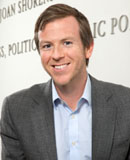Event
Peter Hamby Discusses News at Snapchat, Social Media on the Campaign Trail

September 29, 2015 — Peter Hamby, Head of News at Snapchat and a political contributor for CNN, discussed how Snapchat creates news stories, how campaigns are using the platform, and the ever-evolving relationship between social media and journalism.
Hamby is known as an early adopter of social media platforms, and as a spring 2013 fellow at the Shorenstein Center, he authored “Did Twitter Kill The Boys On The Bus?”, a widely-circulated study on the impact of Twitter on media behavior and campaign press strategy.
Snapchat’s audience is very young, said Hamby, with high usage among people under age 25. This demographic contains many first-time voters, who are less likely to watch TV, read newspapers, or even use Facebook.
From this perspective, Hamby views Snapchat’s mission as educational, and emphasized the importance of reaching young people on the platforms they use. “Snapchat is not going to be the place where we’re going to break incremental staffing news, or process-y campaign stories,” he said. “There’s this huge audience – we’re building an editorial structure on top of them and alerting them to things happening in the world.”
Snapchat provides two ways for users to engage with news. The first is Discover, which provides content from publishing partners such as CNN, ESPN, National Geographic, Daily Mail, Buzzfeed, and others. The second method is Live Stories, the initiative that Hamby leads. Live Stories are composed of user-generated video content, curated by Snapchat’s editorial team and assembled into a story about a major event. Timestamps and geocoding built into the platform assist the editorial team in verifying that the source of the video is legitimate. The stories are then broadcast on Snapchat, reaching an audience of 15 million viewers each day, said Hamby.
Recent Live Stories covered the Greek referendum – “not an easy thing to distill into a cascade of 10 second snaps and very short animations” – the tenth anniversary of Hurricane Katrina, the papal visit to Philadelphia, same-sex marriages at courthouses after the Supreme Court ruling, and the Hajj. In contrast to a traditional TV broadcast, “we have everyone’s camera at our disposal,” said Hamby, which sometimes results in access to unique perspectives.
Snapchat users are also learning about the 2016 presidential candidates from the platform, said Hamby. A large portion of Snapchat’s news coverage is focused on politics, and has included stories such as candidate positions on the Iran Deal. Although most of the Republican candidates are focused on winning the Iowa and New Hampshire primaries, and therefore targeting older voters, Hamby said that Scott Walker and John Kasich used Snapchat effectively. The primary reason for this was that both candidates had children and both campaigns had young adults following them on the campaign trail. “They would do great behind the scenes videos – they realized that Snapchat had this ability to capture intimate moments, funny moments, the ability to take you there, to a place you wouldn’t otherwise go,” said Hamby. “Ben Carson is starting to get it,” he added.
Addressing the concern that social media outlets are potentially harming political journalism by encouraging the creation of “clickbait” and focusing on gaffes, Hamby said these critiques are not exclusive to social media. “Whether it’s TV news or tabloid newspapers or muckraking-era journalism, I think that human instinct has always been drawn toward the sensational,” he said. Additionally, news organizations can have “clicky fun stuff” live alongside serious stories; “there’s no limit to space on the Internet,” and the clickbait is how news organizations make money now, said Hamby. “Fundamentally, all the bad impulses of journalism that we collectively deride have always been there.”
On the topic of social media creating silos or echo chambers, Hamby said that Snapchat avoids this problem more than other social media platforms, interestingly enough, by being a bit more like a traditional TV broadcast. In contrast to Facebook, where users are likely to see articles they already agree with, and then share with their like-minded friends, Snapchat focuses less on a “choose your own news ecosystem” in favor of “big moment events – award ceremonies like the Emmys, big football games, groundbreaking world elections, the Pope is visiting somewhere, etc. – you kind of have to be there. And the stories are only there for 24 hours and then they go away.”
Hamby also discussed recent changes in the relationship between campaigns and the media, his thoughts on the viability of Donald Trump’s campaign, journalists and Twitter, and other topics. Listen to the full audio recording above, and subscribe to the Media and Politics Podcast on iTunes.
Article and photo by Nilagia McCoy of the Shorenstein Center.